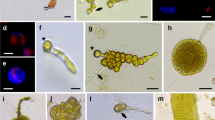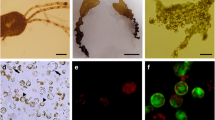Abstract
Functional recombinant abalone alginate lyase (rHdAly) and β-1,4-endoglucanase (rHdEG66) were expressed as secreted proteins with baculoviral expression systems. The specific activity of each recombinant enzyme, 2,490 and 18.2 U/mg for rHdAly and rHdEG66, respectively, was comparable to its native form at 30°C. Purified rHdAly and rHdEG66 showed the highest specific activity both at 35°C and optimum pH 8.7 and 5.9, respectively. These properties were also comparable to those of the native enzymes. Protoplast isolation was attempted from Laminaria japonica using both rHdAly and rHdEG66. When L. japonica blades were incubated in artificial seawater containing rHdAly and rHdEG66, very low numbers of protoplasts (<1 × 103 protoplasts/g fresh weight) resulted. However, using blades pretreated with proteinase K, the protoplast was increased up to 5 × 106 protoplasts/g fresh weight. Since the average diameter of isolated protoplasts was 11.6 μm, these cells were mostly derived from the epidermal layer rather than the cortical layer. Our results suggest that at least three enzymes, alginate lyase, cellulase, and protease, are essential for effective protoplast isolation from L. japonica. The protoplast isolation method in this study is more useful than earlier methods because it preferentially yielded protoplasts of the epidermal layer, which are known to be able to be regenerated.




Similar content being viewed by others
References
Boyen C, Kloareg B, Polne-Fuller M (1990) Preparation of alginate lyases from marine molluscs from protoplast isolation in brown algae. Phycologia 29:173–181
Bradford MM (1976) A rapid and sensitive method for the quantitation of microgram quantities of protein utilizing the principle of protein-dye binding. Anal Biochem 72:248–254
Butler DM, Ostgaard K, Boyen C, Evans LV, Jensen A, Kloareg B (1989) Isolation conditions for high yields of protoplasts from Laminaria saccharina and Laminaria digitata (Phaeophyceae). J Exp Bot 40:1237–1246
Cassab GI (1998) Plant cell wall proteins. Annu Rev Plant Physiol Plant Mol Biol 49:281–309
Coughlan MP (1985) The properties of fungal and bacterial cellulases with comment of their production and application. Biotech Genetic Eng Rev 3:39–109
Day RW, Fleming AE (1992) The determinants and measurement of abalone growth. In: Shepherd SA, Tegner MJ, Guzmán Del Próo SA (eds) Abalone of the world: Biology, fisheries and culture. Wiley-Blackwell, NJ, pp 141–168
Ducreux G, Kloareg B (1988) Plant-regeneration from protoplasts of sphacelaria (Phaeophyceae). Planta 174:25–29
Epstein L, Lamport D (1984) An intramolecular linkage involving isodityrosine in extensin. Phytochemistry 23:1241–1246
Evan GI, Lewis GK, Ramsay G, Bishop JM (1985) Isolation of monoclonal antibodies specific for human c-myc proto-oncogene product. Mol Cell Biol 5:3610–3616
Fisher D, Gibor A (1987) Production of protoplasts from the brown alga, Sargassum muticum (Yendo) Fensholt (Phaeophyta). Phycologia 26:488–495
Fry SC (1982) Isodityrosine, a new cross-linking amino acid from plant cell-wall glycoprotein. Biochem J 204:449–455
Habermann E, Jentsch J (1967) Sequence analysis of melittin from tryptic and peptic degradation products. Hoppe Seylers Z Physiol Chem 348:37–50
Inoue A, Kagaya M, Ojima T (2008) Preparation of protoplasts from Laminaria japonica using native and recombinant abalone alginate lyases. J Appl Phycol 20:633–640
Kieliszewski MJ, Lamport DT (1994) Extensin: repetitive motifs, functional sites, post-translational codes, and phylogeny. Plant J 5:157–172
Kubicek CP (1992) The cellulase proteins of Trichoderma reesei: Structure, multiplicity, mode of action and regulation of formation. Adv Biochem Eng Biotechnol 45:1–27
Lamport D (1965) The protein component of primary cell walls. Adv Bot Res 2:151–218
Lynd LR, Weimer PJ, Van Zyl WH, Pretorius IS (2002) Microbial cellulose utilization: fundamentals and biotechnology. Microbiol Mol Biol Rev 66:506–577
Matsumura W, Yasui H, Yamamoto H (2000) Mariculture of Laminaria japonica (Laminariales, Phaeophyceae) using protoplast regeneration. Phycol Res 48:169–176
Muramatsu T, Hirose S, Katayose M (1977) Isolation and properties of alginate lyase from the mid-gut gland of wreath shell Turbo cornutus. Agric Biol Chem 41:1939–1946
Muramatsu T, Komori K, Sakurai N, Yamada K, Awasaki Y, Fukuda K, Oda T (1996) Primary structure of mannuronate lyases SP1 and SP2 from Turbo cornutus and involvement of the hydrophobic C-terminal residues in the protein stability. J Protein Chem 15:709–719
Nevalainen H, Pentilla M (1995) Molecular biology of cellulolytic fungi. In: Kuck I (ed) The mycota II genetics and biotechnology. Springer-Verlag, Berlin, pp 303–319
Park JT, Johnson MJ (1949) A submicrodetermination of glucose. J Biol Chem 181:149–151
Polnefuller M, Gibor A (1987) Calluses and callus-like growth in seaweeds—induction and culture. Hydrobiologia 151:131–138
Porzio MA, Pearson AM (1977) Improved resolution of myofibrillar proteins with sodium dodecyl sulfate-polyacrylamide gel electrophoresis. Biochim Biophys Acta 490:27–34
Saga N (1989) Further study on determining cell viability in marine red and brown algae by using staining dyes. Bull Hokkaido Reg Fish Res Lab 53:43–53
Saga N, Sakai Y (1984) Isolation of protoplasts from Laminaria and Porphyra. Bull Jap Soc Sci Fish 50:1085–1085
Saloheimo A, Henrissat B, Hoffren AM, Teleman O, Penttila M (1994) A novel, small endoglucanase gene, egl5, from Trichoderma reesei isolated by expression in yeast. Mol Microbiol 13:219–228
Sawabe T, Ezura Y (1996) Regeneration from Laminaria japonica Areschoug (Laminariales, Phaeophyceae) protoplasts isolated with bacterial alginase. Plant Cell Rep 15:892–895
Sawabe T, Ezura Y, Kimura T (1993) Application of an alginate lyase from Alteromonas sp. for isolation of protoplasts from a brown algae Laminaria japonica. Bull Jap Soc Sci Fish 59:705–709
Shepherd SA, Steinberg PD (1992) Food preferences of three Australian abalone species with a review of the algal food of abalone. In: Shepherd SA, Tegner MJ, Guzmán Del Próo SA (eds) Abalone of the world: Biology, fisheries and culture. Wiley-Blackwell, NJ, pp 169–181
Shimizu E, Ojima T, Nishita K (2003) cDNA cloning of an alginate lyase from abalone, Haliotis discus hannai. Carbohyd Res 338:2841–2852
Suzuki K, Ojima T, Nishita K (2003) Purification and cDNA cloning of a cellulase from abalone Haliotis discus hannai. Eur J Biochem 270:771–778
Suzuki H, Suzuki K, Inoue A, Ojima T (2006) A novel oligoalginate lyase from abalone, Haliotis discus hannai, that releases disaccharide from alginate polymer in an exolytic manner. Carbohyd Res 341:1809–1819
Vlasak R, Unger-Ullmann C, Kreil G, Frischauf AM (1983) Nucleotide sequence of cloned cDNA coding for honeybee prepromelittin. Eur J Biochem 135:123–126
Wakabayashi T, Kuboi T, Tuboi T, Kaji M, Hara M (1999) Preparation of high yields of algal protoplasts using buccal juice of sea hare and commercial cellulase. Mar Biotech 1:407–410
Wong TY, Preston LA, Schiller NL (2000) ALGINATE LYASE: review of major sources and enzyme characteristics, structure-function analysis, biological roles, and applications. Annu Rev Microbiol 54:289–340
Wood T (1989) Mechanisms of cellulose degradation by enzymes from aerobic and anaerobic fungi. In: Coughlan MP (ed) Enzyme systems for lignocellulose degradation. Elsevier, NY, pp 19–35
Yamamoto S, Sahara T, Sato D, Kawasaki K, Ohgiya S, Inoue A, Ojima T (2008) Catalytically important amino-acid residues of abalone alginate lyase HdAly assessed by site-directed mutagenesis. Enz and Microbial Techn 43:396–402
Acknowledgements
This work was supported by a Grant-in-Aid for Young Scientists (B) no. 20780150 from the Ministry of Education, Culture, Sports, Science and Technology (MEXT), Japan and the Akiyama Foundation.
Author information
Authors and Affiliations
Corresponding author
Rights and permissions
About this article
Cite this article
Inoue, A., Mashino, C., Kodama, T. et al. Protoplast Preparation from Laminaria japonica with Recombinant Alginate Lyase and Cellulase. Mar Biotechnol 13, 256–263 (2011). https://doi.org/10.1007/s10126-010-9290-2
Received:
Accepted:
Published:
Issue Date:
DOI: https://doi.org/10.1007/s10126-010-9290-2




